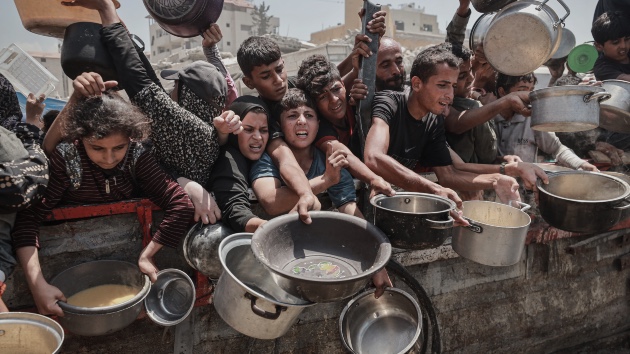
(NEW YORK) — The U.N.-backed Integrated Food Security Phase Classification (IPC) said last week that famine was determined in parts of Gaza for the first time.
The IPC report projected that famine would expand in the region by the end of September and more than 100,000 children under age 5 were at risk of death from acute malnutrition through June 2026.
In a statement, the Israeli prime minister’s office called the IPC’s determination of famine “an outright lie” and “a modern blood libel.”
Humanitarian experts and doctors described the report as unsurprising — a situation they have warned about for months — but “appalling” nonetheless.
“The situation itself is appalling,” Scott Paul, director of peace and security for the non-governmental organization Oxfam America, told ABC News. “I think if anyone is surprised by this news, then they haven’t been paying attention to the repeated warnings of local communities, Palestinian organizations, international organizations and other states and humanitarian donors.”
Aid organizations have said the next steps after such a report are securing an immediate, and permanent, ceasefire and opening border crossings to allow unhindered access of humanitarian aid and medical supplies.
While some experts told ABC News it’s not too late to increase aid and ready-to-eat therapeutic food for cases of malnutrition, others are less optimistic that the report will result in meaningful change.
“What will be done will be nothing,” Dr. John Kahler, a pediatrician and co-founder of MedGlobal, who has been on multiple medical missions to Gaza, told ABC News. “There’s plenty of money and plenty of resources available. It’s 100% access. And so, this [famine determination] won’t do a thing to move that needle.”
He added, “I’m in a difficult position with organizations at large, because they think the production of yet another document has some dramatic meaning. We knew this.”
To determine if a famine is happening, three thresholds have to be met: 20% of households must be facing an extreme food shortage, 30% of children must be acutely malnourished and either two adults or four children must be dying every day per 10,000 people, according to the IPC.
A termination is separate from a declaration. The IPC itself doesn’t issue official declarations of famine, but its findings can inform governments and bodies such as the U.N. to make a famine declaration.
Humanitarian experts have said there is no legal mechanism that a government body or the U.N. would have to go through to formally declare a famine.
“Governments or international organizations might have their own sort of processes internally to go into famine mode, but I don’t think that anyone should be holding their breath for a piece of paper that says ‘famine declaration’ on the top, because that likely won’t come,” Paul, of Oxfam America, said.
He noted that the U.N. Emergency Relief Coordinator already addressed the famine determination during a press conference with reporters on Friday and acknowledged it in the wake of the IPC classification.
“This isn’t the penultimate step. This is it. We have arrived at famine,” Paul said.
Kahler agreed, adding that the IPC report should not be taken as a warning — rather that the warning should have occurred months ago with previous reports.
“The health system’s collapsed, the educational system’s collapsed, the public health system’s collapsed,” he said. “I’m not sure what else to warn people about.”
Paul said normally what would follow would be an immediate “all hands-on deck” effort from the U.S. government and others to influence the Israeli government to secure a ceasefire and increase the flow of aid, which he said should have been done with prior warnings of emergency levels of food insecurity famine warnings.
Since May, the U.S. has participated in providing aid to Gaza through the Gaza Humanitarian Foundation, which set up designated aid distribution sites rather than delivering aid throughout the strip. Palestinians and aid organizations reported incidents of people being shot at while trying to retrieve aid as well as general chaos at the sites, which continues to be an ongoing issue.
The Israel Defense Forces has previously said it only fires “warning shots” toward people who are allegedly “advancing while posing a threat to the troops.” The Israeli government has also previously claimed that Hamas shoots people waiting in food lines and films the events for propaganda videos. Hamas has denied these claims.
Israeli officials have argued there are hundreds of truckloads of aid sitting at the border for the U.N. and its partners to distribute. The U.N., however, said it can’t deliver the aid safely.
“One of the things that is not well understood is how complex it is for the United Nations to do our work here in the Gaza Strip,” Tess Ingram, a spokesperson for UNICEF who is currently in Gaza, told ABC News. “I think what is not well understood is the challenges that we face on a daily basis that impede our work. It’s like a game of ‘Snakes and Ladders.’ We take one step forward and then we have to take two steps backwards because there are constantly hurdles in front of us that we have to overcome, and many of these hurdles do not need to be there.”
These threats include poor road conditions, lack of route alternatives, poor telecommunications, large crowds of desperate people and unpredictable supply lines, according to the U.N.
Paul noted that a prior IPC report, issued at the end of July, found that a “worst-case scenario of famine” was unfolding in Gaza.
“It was less than a few weeks ago that the same technical body on hunger issued a very clear warning [on] famine, which is about as close as they can come to an official confirmation without doing it,” he said. “The situation will get worse, and famine will continue to spread as long as all routes for humanitarian assistance … is not immediately opened up.”
Copyright © 2025, ABC Audio. All rights reserved.


